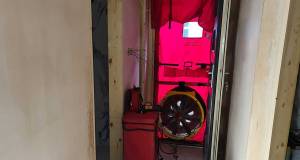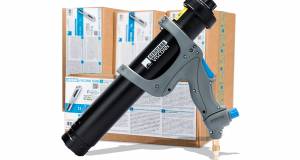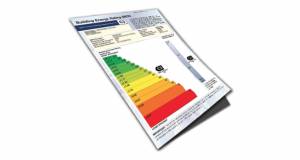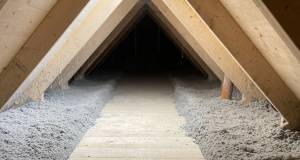Under rated
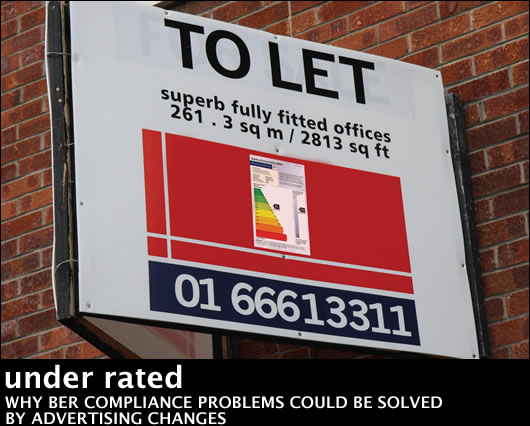
Mandatory for virtually all building types since January of this year, Building Energy Ratings have been met with little fanfare. Construct Ireland proposes a cost-free method of levelling the marketplace by ensuring compliance and increasing awareness of the BERs legal status. Jason Walsh explains.
Some 2,678 BER assessors have been registered by Sustainable Energy Ireland since the scheme began – in this regard alone, Building Energy Ratings must be considered a success. Now mandatory for almost all building types, BERs are a fact that the industry – from architects and developers to auctioneers and landlords – must face up to.
Unsurprisingly, not everyone has welcomed the BERs. Some estate agents are already responding to the introduction of BERs by ramping up fear, doubt and uncertainty. Few, if any, estate agents have openly attacked BERs but trade bodies have been complaining about certain aspects of the system.
In January the Irish Auctioneers and Valuers Institute (IAVI) complained that SEI had "unleashed" untrained assessors onto the Irish property market.
One commercial umbrella organisation for a number of estate agents and auctioneers, Real Estate Alliance, meanwhile, has complained that in a market where values have declined sharply adding an additional cost which they estimate at e300 for the assessment added to the price of a sale is unwelcome.
"With surveys costing approximately e300, it is very understandable that vendors don’t want to commit to having a certificate carried out until there is a greater hope of a sale", said Paul G. Grimes, chairman of Real Estate Alliance.
The declines are real and ongoing: the average price paid for a house nationally in February 2009 was e255,999. In December 2008 it was e261,573 and peaked of e311,078 in February 2007.1 In Dublin, the declines have been even more significant with reductions of 13.3 per cent in the twelve months leading up to February 2009. The average price in Dublin fell from e397,5072 in December 2007 to e339,042 in February 2009.3
One landlord who spoke to Construct Ireland on the condition of anonymity said that those in the rental sector were similarly dubious about BERs, not because they object to them but because as of yet the public is uninterested: "It was a waste of time. You do it and the punter doesn't look at it. You pay e300 – it's created another job, that's about it," he said.
According to the Real Estate Alliance, the situation is identical when it comes to house sales: “Ironically there is no great demand from the public. It is not a frequently asked question by intending purchasers," said Harry Sothern of Sothern Real Estate Alliance in Carlow. "Purchasers are much more interested in normal issues like the appearance of a house, the condition of the property both structurally and decoratively, location or quality of estate, proximity to facilities and value for money. BER comes even further down the list”, he said.
Nevertheless, BERs are now legally mandatory. If the public is uninterested in them it is unfortunate but this situation is bound to change over time. Firstly, the BERs are a relatively new requirement and it will take time for the public to become fully aware of what they are and what each individual rating means. Secondly, a lack of A-rated buildings at the moment may mean that BERs are of less interest than they might otherwise be. However, as the housing stock improves both buyers and renters are likely to be faced with direct choices between energy efficient buildings and inefficient buildings. In such a case, prospective tenants and house-buyers are entitled to fair and direct comparisons.
SEI's figures indicate the average BER is at B2 for new homes and D2 for second-hand, though many older second-hand homes are as low as G – a clear reason for vendors to either want to avoid the BER or, more positively, upgrade their homes prior to sale in order to increase the chance of sale.
SEI's Paula Rice says that the industry has been aware of the requirement for BERs for some time: "We’ve done a phenomenal amount of public events and spoken to people – the professional market were certainly very well prepared, it was signalled years ago.
"Also, this is why it was phased in – it came in for new dwellings in January '07," she said.
SEI's internal auditing reveals that both the industry and the public have been in contact about BERs as a direct result of advertising campaigns: "At its peak we were getting 275 calls a day and 125 emails a day," said Rice.
There is arguably some truth in the IAVI's allegation, however. So far none of the 2,600 plus assessors have passed a standardised national test to become assessors for existing buildings – because they haven't been asked to. This, however, is about to change.

Mick Boyd and Paul Grimes of Real Estate Alliance
Testing times
Construct Ireland learned shortly before going to print that a contract has been agreed with Ireland's driving licence test centres to make the BER exam available at their locations from June 2009. In addition, there will be a number of mobile units available to cover other areas.
The test will be free until August to registered assessors, all of whom must pass the test in order to retain their registered status. After that period the examination will cost e100. One industry source told Construct Ireland the tests were well thought-out: "In order to pass you must score an average of at least 70 per cent. In addition, you must get at least 50 per cent in each category."
This means that any potential assessor who excels in one or more areas cannot pass on this basis alone. An assessor must rather, at least to a point, be knowledgeable in all relevant areas, a fact that should reassure concerned consumers.
All currently registered assessors have been tested as part of their training but this new test will form a mandatory national standard.
The test will undoubtedly lead to a certain attrition rate as some assessors –already underwhelmed by the lack of work – choose to bow-out of the industry, but given that the housing market is presently in a distressed state it is fair comment to argue that Ireland has too many assessors and likely will still have too many after August 2009.
All of the industry insiders that Construct Ireland spoke to agreed that BER assessment is not necessarily a full-time job in and of itself. Ray Hennessy of the BER Association sounded a note of caution: "In effect, you don't want BER assessment becoming like taxi driving in the current economic climate: people get laid-off and just decide 'I'll do the BERs'.
"There's not enough work to do that," he said.
Some in the industry have complained that SEI has registered too many assessors and there are reports of the existence of three potential assessors per property. It is difficult, however, to see what SEI could have done about this. Placing an artificial limit on the amount of assessors would be a difficult decision to defend and could run into problems with competition law, as only a handful of professions are protected from market forces.4
Paula Rice explained that SEI's position is simply that BERs were not intended to be an industry in their own right: "We did not want to create a new profession, this is something that people in the construction industry can use to add a string to their bow."
Lower than expected demand for BERs is an unfortunate side-effect of a major downturn in house sales but it is one that seems difficult to avoid. Ray Hennessy remains cautiously optimistic about the situation: "BERs are working – despite everything there are 500 domestic ones [performed] a day.
"The bottom line is there is a market requirement for 1,000 assessors," he said.

Following Construct Ireland’s proposal, environment minister John Gormley (above) is considering making the display of BERs mandatory on property advertising
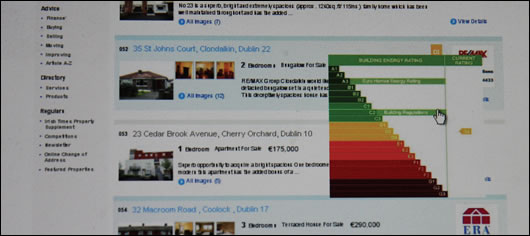
A property search on myhome.ie brings up a BER, although most listed properties do not advertise their rating
|
The Construct Ireland proposal in detail: Construct Ireland proposes a system to increase the efficacy of the building energy rating system by making it much more visible. The idea is a simple one, but it could have a significant effect: in short, all advertisements for property should include a prominently displayed BER score. The key area for this would be on 'for sale' and 'to let' signs advertising property in the street as this would build up an understanding of what BERs are, and the relative differences between different properties. Newspaper advertisements and listings, property web sites such as Daft.ie and property notices in estate agent windows would also be subject to the same requirement. Indeed, with the media shouldering a portion of the blame for inflating the property bubble this would be a way of ensuring that advertisements would be truly informative and useful. This suggestion has two key benefits. Firstly, it would raise awareness of the building energy rating among the public. Secondly, it would significantly reduce the cost of policing the system. Any property advertisement without a visible BER would arouse suspicion and could easily be reported to Sustainable Energy Ireland or the building control inspectorate for investigation, thus doing away with the need for roaming agents checking properties up and down the country. This proposal would also have the added benefit of boosting construction activity. As a result of changes to Part L of the Building Regulations introduced last year, all new homes should be achieving at least a B1 BER. Prospective buyers and tenants would therefore become more aware of the benefits of living in a new home. Similarly, a poor BER on an existing house would raise the homebuyer’s awareness of the need to invest in an energy upgrade, once more resulting in construction work. |
One area that has bedevilled the introduction of BERs is policing. How will they be enforced and by whom?
One of Ireland’s leading BER experts told Construct Ireland that there is a grey area over who's responsible for enforcing BERs: "Is it the local authorities or is it SEI? Will local authorities' building control officers see it as work they simply don't have the budget to perform?"
It's a good question. Construct Ireland was able to confirm an answer with Sustainable Energy Ireland. Paula Rice said the enforcement is clear: "The building control authorities are given the enforcement powers and they come under the Department of the Environment.
"SEI's role is about enforcement over the assessors, auditing them and ensuring they are all properly registered," she said.
Building control officers do have a technical duty to perform. Additionally, checking the validity of BERs does not require a site visit, which should make the task substantially easier for Ireland’s under-resourced building control inspectorate.
"It's very much an administrative task that can be handled by letter to the estate agents asking for lists and certificates," said Ray Hennessy. "Sellers or their agents can't fiddle the figure because they're available to the public via SEI."
The objective is to create a level playing field where all estate agents will inform clients of the necessity of having a BER assessment performed prior to sale, thereby ensuring that would-be vendors are not able to circumvent a cost that everyone must pay.
Interestingly, Mick Boyd, vice chairman of Real Estate Alliance accepts that policing is necessary: “[t]he BER requirements have been met with thundering silence from all participants in the market. Vendors do not want the cost, buyers do not care for it just now and the legions of assessors are very angry and disillusioned with the dismal take up of the scheme," he said. Mr Boyd predicts the SEI will start policing the roll out of BER to enforce take-up.
One idea that Construct Ireland editor Jeff Colley proposed to senior officials in the Department of the Environment last year may go some way toward easing the difficulties in enforcement while also raising awareness of BERs: making BER results visible on all advertising and notices related to building sales and lettings.
The key to the idea is to make a BER certificate as visible as a vehicle registration plate, with the result that a building being sold without one would be noticed. The same concept has subsequently been proposed at European Parliament level in the current plans to recast the Energy Performance of Buildings Directive.
The current Irish legislation, whilst not going this far, demands that buildings have a valid BER before a sale or letting has been agreed. SI: 666 OF 2006 states that any person offering a building for sale or rental “shall produce a printed copy of the BER certificate and advisory report in relation to the building to any person expressing an interest in purchasing or taking a letting of the building”. In practical terms, this means that even someone calling or emailing in response to a property listing is entitled to know the building’s BER.
However at present, although a BER certificate is mandatory at the point of offer, it is not required in advertising.
"The regulations as they stand do not require the BER to be in the marketing literature. The recast [Energy Performance of Buildings] directive will change that and we would certainly welcome it," said SEI's Paula Rice.
A spokesperson for environment minister John Gormley told Construct Ireland that the mandatory display of BER certification on advertising is being looked at: "He's supporting its introduction in the recast directive and is looking at introducing it in advance here in Ireland," he said.
The recast EPBD is expected to become law in January 2011 – a long wait. Construct Ireland is in full agreement with minister Gormley and Sustainable Energy Ireland: it is certainly worth considering adding a requirement for all advertising and marketing material to display BERs in advance of the pending European Union legislation. Such a move would present no extra cost to the state but doing so would ensure the level playing field that all parties involved are seeking.
1 Irish house prices to February 2009, Finfacts. See: http://www.finfacts.ie/biz10/irelandhouseprices.htm
2 Permanent TSB report
3 Op. cit. Finfacts
4 The public should worry when taxi drivers and others want a cap on their numbers, Gorkecki, Paul. Irish Independent, May 5, 2009. See: http://www.independent.ie/business/the-public-should-worry-when-taxi-drivers-and-others-want-a-cap-on-their-numbers-1728423.html
- Articles
- Energy Performance of Buildings Directive
- Under rated
- BER
- blower door test
- airtightness
- assessor
- sei
Related items
-
EU votes through EPBD recast
-
 Partel’s airtight membranes now certified for passive house construction
Partel’s airtight membranes now certified for passive house construction -
 Mass timber masterwork
Mass timber masterwork -
 Partel obtains EPDs for airtight membranes
Partel obtains EPDs for airtight membranes -
 Manhattan modular apartments feature Wraptite membrane
Manhattan modular apartments feature Wraptite membrane -
 Partel’s Izoperm Plus achieves passive house ‘A’ cert
Partel’s Izoperm Plus achieves passive house ‘A’ cert -
 Superb airtightness result for Manchester ICF house
Superb airtightness result for Manchester ICF house -
 Liquid membranes transforming airtightness work — Blowerproof UK
Liquid membranes transforming airtightness work — Blowerproof UK -
 AECB launches new retrofit standard
AECB launches new retrofit standard -
 Pro clima launch spray applicator for airtight paints
Pro clima launch spray applicator for airtight paints -
 BERCerts.ie offering ventilation validation
BERCerts.ie offering ventilation validation -
 Cellulose insulation can boost airtightness — Ecocel
Cellulose insulation can boost airtightness — Ecocel







